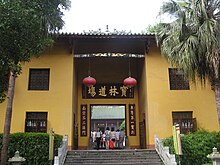Nanhua Temple
| Nanhua Temple | |
|---|---|
南华寺 | |
 Shanmen at Nanhua Temple. | |
| Religion | |
| Affiliation | Buddhism |
| Sect | Chan Buddhism |
| Location | |
| Location | Maba, Qujiang District, Shaoguan, Guangdong |
| Country | China |
| Geographic coordinates | 24°38′57″N 113°37′53″E / 24.64917°N 113.63139°E |
| Architecture | |
| Style | Chinese architecture |
| Founder | Zhiyao Sanzang (智樂三藏) |
| Date established | 502 |
Nanhua Temple (simplified Chinese: 南华寺; traditional Chinese: 南華寺; pinyin: Nánhuá Sì; Jyutping: Naam4wa4zi6) is a Buddhist monastery of the Chan Buddhism, one of Five Great Schools of Buddhism where Huineng, the Sixth Patriarch of Chan Buddhism, once lived and taught.[1][2] It is located in the town of Maba (马坝镇), Qujiang District, 25 km (16 mi) southeast of central Shaoguan, Guangdong province. The location is in the northern part of the province, within a few kilometers from the Bei River.
History[edit]
The temple was founded during the time of the Northern and Southern Dynasties in 502 AD by an Indian monk named Zhiyao Sanzang (智樂三藏) who originally named the site Baolin Temple (寶林寺).[1][2] It received its present name in 968 during the reign of the Song dynasty Emperor Taizong.[3] Ancestor Hanshan Deqing taught there and reformed the monastery in the 16th century.[4] The site was later renovated in 1934 under the leadership of Hsu Yun whose body is housed in the central forest sanctuary. Recent changes to the site include the building of extensive monastic accommodations.
Architecture[edit]
The temple covers an area of more than 42.5 hectares (105 acres). It consists of a set of magnificent Buddhist buildings, including the Hall of Four Heavenly Kings, Mahavira Hall, Sutra Depository, Sixth Ancestor Hall, Lingzhao Pagoda and 690 Buddhist statues.[1][2]
There are 9 Chinese swamp cypresses (Glyptostrobus pensilis) believed to be 400 to 500 years old in the temple.
Caoxi Gate[edit]
Inside the Caoxi Gate (曹溪门), a plaque with the Chinese characters "Nanhua Chan Temple" (南华禅寺) hanging on the door lintel written by the former President of Chinese Buddhist Association, the late Upasaka Zhao Puchu.[5]
Hall of Heavenly Kings[edit]
The majestic Hall of Heavenly Kings was originally built in 1474 during the Ming dynasty (1368–1644) and rebuilt during the Qing dynasty (1644–1911). The statue of Maitreya Bodhisattva is enshrined in the hall and the mighty statues of the four Heavenly Kings holding religious objects stand on both sides of the statue of Maitreya. Behind the hall is a three-storey bell tower which was constructed in 1301 during the Yuan Dynasty (1271–1368). On top of the bell tower there hangs a brass bell from the Southern Song Dynasty (1127–1279). The massive bell is 2.75 meters (9.0 feet) high with a diameter of 1.8 meters (5.9 feet).[5]
Mahavira Hall[edit]
The Mahavira Hall, constructed during the Yuan dynasty (1271–1368), stands in the center of the temple. Covered by glazed tiles, it houses the Buddha statues of Sakyamuni Buddha, Medicine Buddha, and Amitabha, which are situated in the sacrarium of the hall. These gilded figures are all over 8.3 meters (27 feet) high. Within the Grand Hall there are about 500 fine clay sculptures of Buddhist arhats.[5]
The temple holds many precious cultural relics; the most precious being the statue of Hui Neng, which is worshiped in the Sixth Ancestor Hall and the body of Han Shan. There are 360 Buddhist arhat figures which are the only Chinese wooden carvings preserved from the Northern Song Dynasty (960–1127) and a rare cassock trimmed with the dainty embroidery of over 1,000 Buddhist figures.[5]
Early impressions by Jesuits[edit]
The first account of Nanhua Temple for the European audience was most likely provided by Matteo Ricci, who visited it in August or September 1589, when relocating from Zhaoqing to Shaoguan. The Jesuit was impressed by the temple, "magnificent in grandeur", and its fountain, "graciously designed and wonderfully built", as well as by the beautiful surroundings, but viewed the "idol-worshipping emissaries of the Satan" (i.e., the Buddhist clergy) with disdain and prejudice. He saw the relics of the Sixth Patriarch (Lusu, i.e. 六祖, Liu Zu, in Ricci's account) as well. The local authorities had suggested to the missionaries (Ricci and his younger colleague, Antonio Almeida) that they can find a place to live on the temple compound, but they strongly preferred to live in the city instead, closer to the region's ruling elites.[6]
References[edit]
- ^ a b c Zhang Yuhuan (2012a), p. 203.
- ^ a b c Zhang Yuhuan (2012b), p. 247.
- ^ Zhang Yuhuan (2012a), p. 204.
- ^ Lu K'uan Yu, Chan and Zen Teaching, Vol I. New York: Samuel Wieser inc,1993. 153.
- ^ a b c d Zhang Yuhuan (2012a), p. 205.
- ^ De Christiana expeditione apud Sinas, Book Three, Chapter 1. Pages 222-224 in the English translation: Louis J. Gallagher (1953). "China in the Sixteenth Century: The Journals of Matteo Ricci", Random House, New York, 1953. The original Latin text by Nicolas Trigault, De Christiana expeditione apud Sinas suscepta ab Societate Jesu, can be found on Google Books.
Bibliography[edit]
- Zhang Yuhuan (2012a). "Bodhimanda of the Six Patriarch of Chan Buddhism Huineng: Nanhua Temple in Shaoguan" 《禅宗六祖惠能的道场:韶关南华寺》. 《图解中国著名佛教寺院》 [Illustration of Famous Buddhist Temples in China] (in Chinese). Beijing: Contemporary China Publishing House. ISBN 978-7-5154-0135-5.
- Zhang Yuhuan (2012b). "Master Huineng and Nanhua Temple" 《惠能法师与南华寺》. 《图解中国佛教建筑》 [Illustration of Buddhist Architecture in China] (in Chinese). Beijing: Contemporary China Publishing House. ISBN 978-7-5154-0118-8.
External links[edit]
- 佛教禪宗祖庭──南華寺 (in Chinese (China)). People's Daily Online.
- National Key Buddhist Temples in Han Chinese Area
- Towers completed in the 14th century
- 14th-century Buddhist temples
- Buddhist temples in Shaoguan
- Chan temples
- Buildings and structures in Shaoguan
- Tourist attractions in Shaoguan
- Major National Historical and Cultural Sites in Guangdong
- Religious buildings and structures completed in 1301
- Religious buildings and structures completed in 1474

